Would anyone have a good algorithm to measure peaks in growing time series data using Swift (v3)? So, detect peaks as the data is streaming in.
E.g. a Swift version of the smooth z-wave algorithm. That algorithm seems to be suitable.
I would need to detect the peaks as shown below. The data contains positive and negative numbers. Output should be a counter of the peaks, and/or true/false for that specific sample.
Sample dataset (summary of the last series):
let samples = [0.01, -0.02, -0.02, 0.01, -0.01, -0.01, 0.00, 0.10, 0.31,
-0.10, -0.73, -0.68, 0.21, 1.22, 0.67, -0.59, -1.04, 0.06, 0.42, 0.07,
0.03, -0.18, 0.11, -0.06, -0.02, 0.16, 0.21, 0.03, -0.68, -0.89, 0.18,
1.31, 0.66, 0.07, -1.62, -0.16, 0.67, 0.19, -0.42, 0.23, -0.05, -0.01,
0.03, 0.06, 0.27, 0.15, -0.50, -1.18, 0.11, 1.30, 0.93, 0.16, -1.32,
-0.10, 0.55, 0.23, -0.03, -0.23, 0.16, -0.04, 0.01, 0.12, 0.35, -0.38,
-1.11, 0.07, 1.46, 0.61, -0.68, -1.16, 0.29, 0.54, -0.05, 0.02, -0.01,
0.12, 0.23, 0.29, -0.75, -0.95, 0.11, 1.51, 0.70, -0.30, -1.48, 0.13,
0.50, 0.18, -0.06, -0.01, -0.02, 0.03, -0.02, 0.06, 0.03, 0.03, 0.02,
-0.01, 0.01, 0.02, 0.01]
Update: Thanks to Jean-Paul for the initial Swift port. But not sure the z-wave algo is the right one for this dataset. lag=10,threshold=3,influence=0.2 works fine for the last series of the dataset, but I have not been able to find a combination that comes close for the complete dataset.
The issues: with a big lag the first data samples are not included, I need one signal per peak and the algorithm would need further work to be made more efficient.
E.g. result for full dataset, using the Python code, and (e.g.) lag=5,threshold=2.5,influence=0.7 is missing peaks for series 1 and 2, and showing too many false positives in the quiet periods:
Full dataset (should result in 25 peaks):
let samples = [-1.38, -0.97, -1.20, -2.06, -2.26, -0.99, 0.11, -0.47, -0.95, -2.61, -0.88, -0.74, -1.12, -1.19, -1.12, -1.04, -0.72, -1.21, -2.61, -1.41, -0.23, -0.27, -0.43, -1.77, -2.75, -0.61, -0.73, -1.53, -1.02, -1.14, -1.12, -1.06, -0.78, -0.72, -2.41, -1.55, -0.01, -0.44, -0.47, -2.02, -1.66, -0.43, -0.93, -1.51, -0.86, -1.06, -1.10, -0.88, -0.84, -1.26, -2.59, -0.92, 0.29, -0.50, -1.31, -2.40, -0.88, -0.56, -1.09, -1.14, -1.09, -0.90, -0.99, -0.84, -0.75, -2.59, -1.34, -0.08, -0.36, -0.50, -1.89, -1.60, -0.55, -0.78, -1.46, -0.96, -0.97, -1.18, -0.98, -1.10, -1.07, -1.06, -1.79, -1.78, -1.54, -1.25, -1.00, -0.46, -0.27, -0.20, -0.15, -0.13, -0.11, -0.13, -0.09, -0.09, -0.05, 0.02, 0.20, -0.31, -1.35, -0.03, 1.34, 0.52, 0.80, -0.91, -1.26, -0.10, -0.10, 0.53, 0.93, 0.60, -0.83, -1.87, -0.21, 1.26, 0.44, 0.86, 0.73, -2.05, -1.66, 0.31, 1.04, 0.72, 0.63, -0.01, -2.14, -0.48, 0.77, 0.63, 0.58, 0.66, -1.01, -1.28, 0.18, 0.44, 0.09, -0.27, -0.06, 0.06, -0.18, -0.01, -0.08, -0.07, -0.06, -0.06, -0.07, -0.07, -0.06, -0.05, -0.04, -0.03, -0.02, -0.02, -0.03, -0.03, -0.01, 0.01, 0.00, 0.01, 0.05, 0.12, 0.16, 0.25, 0.29, -0.16, -0.69, -1.05, -0.84, -0.54, -0.07, 0.46, 1.12, 1.05, 0.77, 0.68, 0.63, 0.39, -0.96, -1.61, -0.68, -0.14, -0.03, 0.22, 0.31, 0.15, -0.02, 0.11, 0.14, 0.00, 0.04, 0.18, 0.27, 0.14, -0.05, -0.03, -0.08, -0.41, -0.94, -1.03, -0.50, 0.02, 0.52, 1.10, 1.03, 0.79, 0.69, 0.55, -0.34, -1.17, -0.89, -0.54, -0.22, 0.37, 0.47, 0.39, 0.23, 0.00, -0.02, 0.05, 0.10, 0.12, 0.09, 0.05, -0.12, -0.50, -0.89, -0.89, -0.48, 0.00, 0.43, 1.03, 0.95, 0.67, 0.64, 0.47, -0.07, -0.85, -1.02, -0.73, -0.08, 0.38, 0.46, 0.32, 0.15, 0.01, -0.01, 0.09, 0.20, 0.23, 0.19, 0.12, -0.50, -1.17, -0.97, -0.12, 0.15, 0.70, 1.31, 0.97, 0.45, 0.27, -0.73, -1.00, -0.52, -0.27, 0.10, 0.33, 0.34, 0.23, 0.07, -0.04, -0.27, -0.24, 0.10, 0.21, 0.05, -0.07, 0.04, 0.21, 0.29, 0.16, -0.45, -1.13, -0.93, -0.28, 0.04, 0.72, 1.35, 1.05, 0.56, 0.43, 0.17, -0.59, -1.38, -0.76, 0.10, 0.44, 0.46, 0.35, 0.12, -0.07, -0.05, -0.01, -0.07, -0.04, 0.01, 0.01, 0.06, 0.02, -0.03, -0.05, 0.00, 0.01, -0.02, -0.03, -0.02, -0.01, 0.00, -0.01, 0.00, -0.01, 0.00, -0.01, -0.01, 0.00, 0.01, -0.01, -0.01, 0.00, 0.00, 0.01, 0.01, 0.01, 0.04, 0.06, 0.05, 0.05, 0.04, 0.03, 0.00, -0.12, -0.16, -0.09, -0.01, 0.14, 0.07, 0.06, 0.00, -0.03, 0.00, 0.06, 0.06, -0.04, -0.11, -0.02, 0.13, 0.18, 0.21, 0.01, -0.31, -0.92, -1.35, -0.62, 0.03, 0.78, 1.36, 1.07, 0.59, 0.75, 0.42, -1.65, -3.16, -0.97, 0.24, 1.44, 1.50, 0.84, 0.47, 0.56, 0.40, -1.50, -2.71, -1.22, 0.01, 1.20, 1.55, 0.92, 0.44, 0.66, 0.73, -0.43, -2.34, -2.28, -0.72, 0.36, 1.41, 1.56, 0.89, 0.54, 0.67, 0.39, -1.78, -2.75, -1.07, -0.07, 1.16, 1.65, 0.80, 0.47, 0.73, 0.86, -0.24, -1.52, -1.68, -0.39, 0.02, 0.38, 0.60, 0.49, 0.02, -0.42, -0.31, -0.01, 0.08, 0.00, -0.07, -0.05, -0.01, -0.02, -0.04, -0.05, -0.02, -0.01, -0.02, -0.02, -0.03, -0.05, -0.04, -0.03, -0.01, -0.01, 0.00, -0.01, 0.00, 0.01, 0.00, 0.00, 0.00, 0.01, 0.01, -0.01, -0.03, -0.02, -0.01, 0.00, 0.00, 0.00, -0.01, 0.01, 0.00, -0.01, 0.02, 0.07, 0.15, 0.28, 0.31, 0.08, -0.26, -0.54, -0.96, -1.08, -0.27, 0.01, 0.45, 1.18, 1.07, 0.71, 0.65, 0.20, -0.80, -1.30, -0.74, -0.24, 0.29, 0.47, 0.34, 0.15, 0.02, 0.03, -0.02, -0.16, -0.13, 0.05, 0.09, -0.01, -0.08, -0.06, 0.03, 0.13, 0.19, 0.23, 0.18, 0.10, -0.07, -0.44, -0.91, -1.05, -0.64, -0.08, 0.50, 1.12, 1.35, 0.89, 0.58, 0.54, -0.58, -1.27, -1.20, -0.48, 0.19, 0.62, 0.62, 0.37, -0.01, -0.35, -0.33, 0.07, 0.29, 0.10, -0.14, -0.10, 0.07, 0.07, 0.01, 0.03, 0.09, 0.20, 0.32, 0.26, -0.02, -0.32, -0.78, -1.25, -0.93, -0.16, 0.30, 0.88, 1.40, 1.14, 0.72, 0.48, -0.54, -1.21, -1.13, -0.41, 0.18, 0.51, 0.53, 0.36, 0.11, -0.03, -0.09, -0.28, -0.11, 0.11, 0.15, 0.04, -0.08, -0.04, 0.04, 0.09, 0.16, 0.26, 0.43, 0.09, -0.88, -1.46, -0.64, -0.16, 0.43, 1.37, 1.34, 0.84, 0.52, -0.17, -0.87, -1.22, -0.76, 0.03, 0.47, 0.60, 0.36, 0.04, -0.09, -0.03, 0.02, -0.04, 0.04, 0.12, 0.13, 0.19, 0.27, 0.31, 0.18, -0.42, -0.99, -1.13, -0.75, -0.22, 0.50, 1.42, 1.41, 0.98, 0.51, 0.29, -0.69, -1.59, -0.88, -0.13, 0.31, 0.49, 0.46, 0.30, 0.05, -0.08, -0.03, 0.01, -0.04, -0.06, 0.02, 0.03, 0.01, -0.02, 0.01, 0.04, 0.06, 0.04, 0.03, 0.02, 0.03, 0.03, 0.01, -0.01, 0.00, 0.02, 0.00, 0.02, 0.02, 0.02, -0.02, -0.01, 0.02, 0.02, 0.01, 0.02, 0.02, 0.02, 0.02, 0.04, 0.03, 0.01, 0.01, 0.02, 0.01, 0.01, 0.01, 0.02, 0.01, 0.00, 0.01, 0.01, 0.00, 0.00, 0.01, 0.00, 0.00, 0.01, 0.00, 0.02, 0.00, 0.00, 0.01, 0.01, 0.00, 0.00, 0.01, 0.01, 0.00, 0.00, 0.00, 0.01, 0.01, 0.00, 0.01, 0.00, 0.01, 0.01, 0.01, 0.01, 0.01, 0.01, 0.00, 0.00, 0.00, 0.00, 0.00, 0.00, 0.00, 0.01, 0.01, 0.01, 0.00, 0.00, 0.00, 0.00, 0.00, 0.00, 0.00]
I am therefore not sure the z-wave algorithm is the right approach for this kind of dataset.



